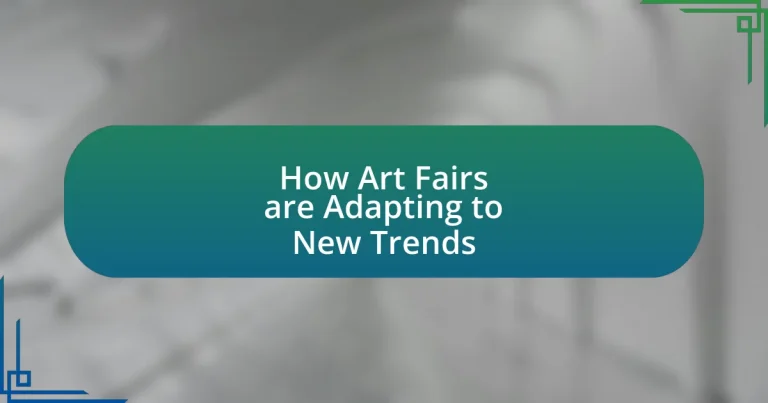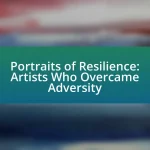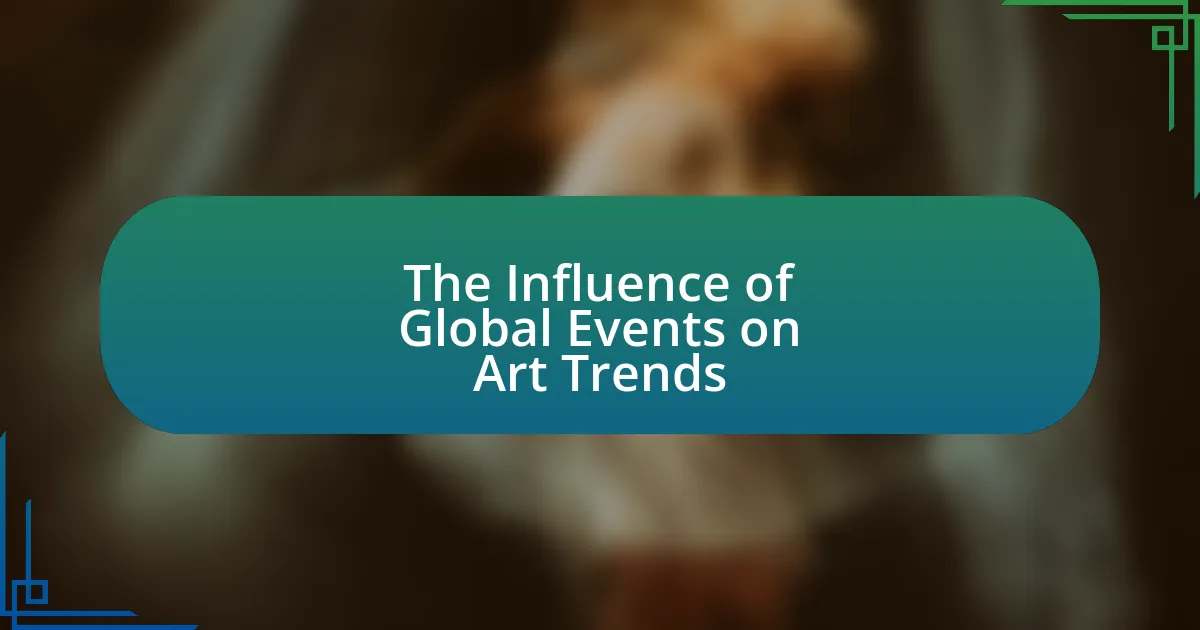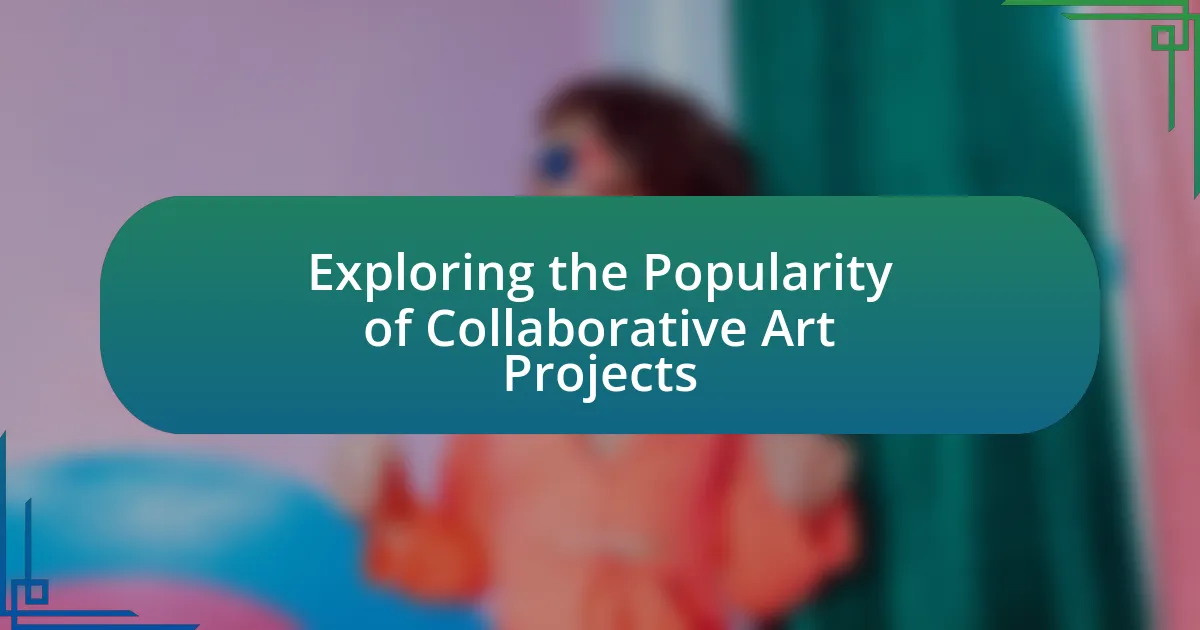Art fairs are evolving to meet new trends by integrating digital platforms, enhancing visitor experiences, and prioritizing sustainability. The rise of online viewing rooms and immersive installations reflects a shift towards experiential consumption, allowing galleries to reach broader audiences and adapt to changing consumer preferences. Key trends influencing this evolution include the adoption of technology, increased focus on inclusivity, and the diversification of programming to engage younger demographics. Additionally, art fairs face challenges in balancing traditional practices with innovative approaches while navigating economic factors and logistical complexities. This article explores how art fairs are leveraging technology, implementing sustainable practices, and adapting to audience expectations to remain relevant in a competitive cultural landscape.

How are Art Fairs Evolving in Response to New Trends?
Art fairs are evolving by integrating digital platforms and enhancing visitor experiences to adapt to new trends. The rise of online viewing rooms and virtual exhibitions has allowed galleries to reach broader audiences, as evidenced by the significant increase in online sales, which accounted for 25% of total art sales in 2021, according to the Art Basel and UBS Global Art Market Report. Additionally, art fairs are incorporating immersive experiences and interactive installations to engage visitors more deeply, reflecting a shift towards experiential consumption in the art market. This evolution demonstrates how art fairs are responding to technological advancements and changing consumer preferences.
What are the key trends influencing art fairs today?
Key trends influencing art fairs today include the rise of digital platforms, increased focus on sustainability, and the integration of diverse art forms. Digital platforms have expanded access to global audiences, allowing art fairs to reach collectors and enthusiasts beyond physical locations. According to a report by Art Basel and UBS, online sales in the art market reached $12.4 billion in 2021, highlighting the shift towards digital engagement. Sustainability has become a priority, with many fairs adopting eco-friendly practices, such as reducing waste and promoting sustainable art. Additionally, art fairs are increasingly showcasing a wider range of artistic expressions, including performance art and installations, reflecting a broader cultural dialogue. This evolution is supported by data from the International Art Fair Association, which notes a growing demand for inclusivity and representation in the art world.
How is technology reshaping the experience of art fairs?
Technology is reshaping the experience of art fairs by enhancing accessibility, engagement, and interaction through digital platforms and tools. Virtual reality (VR) and augmented reality (AR) allow attendees to experience artworks in immersive environments, while online viewing rooms enable global participation, breaking geographical barriers. For instance, the Art Basel fair introduced a digital platform that attracted over 100,000 visitors in 2020, demonstrating how technology can expand audience reach. Additionally, social media integration facilitates real-time sharing and interaction, allowing galleries and artists to connect with potential buyers and art enthusiasts instantly. These technological advancements not only transform how art is displayed and sold but also redefine the overall visitor experience at art fairs.
What role does sustainability play in the evolution of art fairs?
Sustainability plays a crucial role in the evolution of art fairs by driving the adoption of eco-friendly practices and materials. As awareness of environmental issues increases, art fairs are implementing sustainable initiatives such as reducing waste, utilizing renewable resources, and promoting artworks that reflect ecological themes. For instance, many art fairs now prioritize the use of recycled materials in booth construction and encourage galleries to showcase artists who focus on sustainability in their work. This shift not only aligns with global sustainability goals but also attracts a growing audience that values environmental responsibility, thereby enhancing the relevance and appeal of art fairs in contemporary society.
Why are art fairs adapting to changing audience expectations?
Art fairs are adapting to changing audience expectations to enhance engagement and relevance in a competitive cultural landscape. As audiences increasingly seek interactive and immersive experiences, art fairs are incorporating technology, such as virtual reality and augmented reality, to create more dynamic environments. Additionally, demographic shifts, including a younger audience that values inclusivity and diversity, have prompted art fairs to showcase a broader range of artists and artistic expressions. This adaptation is evidenced by the rise of hybrid models that combine physical and digital elements, allowing for greater accessibility and participation. For instance, the Art Basel fair has expanded its online viewing rooms, reflecting the demand for digital engagement alongside traditional exhibitions.
How are demographics influencing the programming of art fairs?
Demographics are significantly influencing the programming of art fairs by shaping the types of artists, artworks, and themes that are featured. As the audience for art fairs becomes increasingly diverse in terms of age, ethnicity, and socioeconomic status, organizers are responding by curating exhibitions that reflect this diversity. For instance, younger collectors, particularly millennials and Gen Z, prioritize inclusivity and social issues, prompting art fairs to showcase works that address contemporary societal challenges. Additionally, according to a report by Art Basel and UBS, the global art market has seen a rise in participation from underrepresented artists, which is a direct response to demographic shifts. This trend indicates that art fairs are adapting their programming to attract a broader audience and remain relevant in a changing cultural landscape.
What new formats are being introduced to engage visitors?
New formats being introduced to engage visitors at art fairs include virtual reality experiences, interactive installations, and hybrid events that combine in-person and online participation. These formats enhance visitor engagement by providing immersive experiences that allow for deeper interaction with the art and artists. For instance, virtual reality experiences enable visitors to explore artworks in a digital space, while interactive installations encourage active participation, making the art more accessible and relatable. Hybrid events have gained popularity, especially post-pandemic, as they cater to a broader audience by allowing remote attendance, thus increasing overall visitor engagement and participation.
What challenges do art fairs face in adapting to these trends?
Art fairs face significant challenges in adapting to new trends, primarily due to the rapid evolution of technology and changing consumer preferences. The integration of digital platforms for art sales requires art fairs to invest in technology and training, which can strain budgets and resources. Additionally, the shift towards online viewing rooms and virtual exhibitions diminishes the traditional in-person experience that many collectors and artists value, leading to potential declines in attendance and engagement. Furthermore, art fairs must navigate the complexities of maintaining relevance in a saturated market, where numerous events compete for attention, making it difficult to attract both exhibitors and visitors. These challenges highlight the need for art fairs to innovate continuously while balancing the preservation of their core identity.
How do economic factors impact the evolution of art fairs?
Economic factors significantly influence the evolution of art fairs by shaping their scale, location, and participant demographics. For instance, during economic downturns, art fairs may see reduced attendance and fewer exhibitors, leading to smaller events or even cancellations, as evidenced by the decline in major fairs like Art Basel during the 2008 financial crisis. Conversely, in periods of economic growth, art fairs often expand, attracting a wider range of galleries and collectors, which enhances their prestige and marketability. Additionally, fluctuations in disposable income affect collectors’ purchasing power, directly impacting sales at these events. The rise of online platforms, driven by economic shifts towards digital commerce, has also transformed traditional art fair models, allowing for hybrid formats that cater to a broader audience.
What are the logistical challenges of implementing new trends?
The logistical challenges of implementing new trends in art fairs include managing increased operational complexity, coordinating diverse stakeholder interests, and ensuring effective communication. Art fairs must adapt to new technologies and audience expectations, which can complicate logistics such as transportation, installation, and scheduling. For instance, integrating digital platforms requires additional training for staff and adjustments in workflow, which can lead to delays and increased costs. Furthermore, balancing the needs of galleries, artists, sponsors, and attendees often results in conflicting priorities, making it difficult to achieve consensus on new initiatives. These challenges are evident in the 2021 Art Basel fair, where organizers faced difficulties in aligning digital and physical experiences while maintaining a cohesive visitor experience.
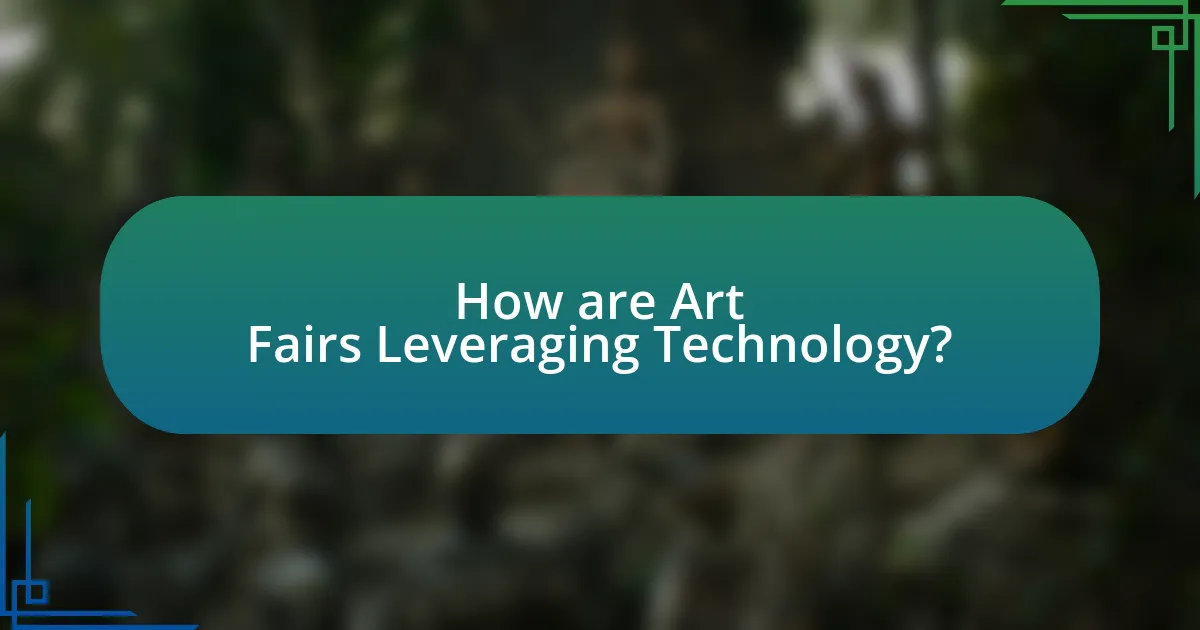
How are Art Fairs Leveraging Technology?
Art fairs are leveraging technology by integrating virtual platforms, enhancing visitor engagement through augmented reality, and utilizing data analytics for targeted marketing. Virtual platforms allow art fairs to reach a global audience, exemplified by events like Art Basel’s online viewing rooms, which expanded access to artworks beyond physical limitations. Augmented reality applications enable attendees to visualize art in their own spaces, increasing interaction and interest. Additionally, data analytics tools help organizers understand visitor preferences and behaviors, allowing for more effective marketing strategies and personalized experiences. These technological advancements are reshaping the art fair landscape, making it more accessible and engaging for diverse audiences.
What technological innovations are being adopted by art fairs?
Art fairs are adopting several technological innovations, including virtual reality (VR), augmented reality (AR), and online platforms for digital exhibitions. These technologies enhance visitor engagement and broaden accessibility, allowing attendees to experience artworks in immersive environments or view them remotely. For instance, VR enables users to explore virtual galleries, while AR can overlay digital information onto physical artworks, enriching the viewing experience. Additionally, many art fairs are utilizing online sales platforms, which have seen a significant increase in usage, particularly during the COVID-19 pandemic, facilitating transactions and expanding market reach.
How are virtual and augmented reality enhancing visitor experiences?
Virtual and augmented reality are enhancing visitor experiences by providing immersive and interactive environments that engage audiences more deeply than traditional methods. These technologies allow visitors to explore art in innovative ways, such as viewing 3D installations or participating in virtual tours of galleries from anywhere in the world. For instance, the use of augmented reality apps at art fairs enables attendees to visualize artworks in their own spaces, enhancing personal connection and understanding. Additionally, studies show that immersive experiences can increase visitor retention and satisfaction, with a report from the International Journal of Arts Management indicating that 70% of participants in VR art experiences felt more engaged compared to conventional exhibitions.
What platforms are art fairs using for online engagement?
Art fairs are using platforms such as Artsy, Artland, and Instagram for online engagement. These platforms facilitate virtual exhibitions, artist showcases, and audience interaction, allowing art fairs to reach a broader audience beyond physical locations. For instance, Artsy reported that it has partnered with over 4,000 galleries and institutions, enabling them to present their works online effectively. Additionally, Instagram serves as a visual platform where galleries and artists can engage with potential buyers and art enthusiasts through posts, stories, and live events, enhancing visibility and interaction.
Why is data analytics important for art fairs?
Data analytics is important for art fairs because it enables organizers to understand visitor behavior, optimize marketing strategies, and enhance overall attendee experience. By analyzing data such as ticket sales, visitor demographics, and engagement metrics, art fairs can tailor their offerings to meet the preferences of their audience. For instance, a study by Art Basel and UBS in 2021 highlighted that 70% of galleries reported using data analytics to inform their exhibition strategies, demonstrating its role in driving sales and improving visitor satisfaction. This data-driven approach allows art fairs to adapt to new trends and make informed decisions that enhance their relevance in a competitive market.
How can art fairs use data to improve visitor engagement?
Art fairs can use data analytics to enhance visitor engagement by analyzing attendee behavior and preferences. By collecting data through ticket sales, social media interactions, and on-site surveys, art fairs can identify trends in visitor demographics and interests. For instance, a study by the National Endowment for the Arts found that targeted marketing based on visitor data can increase attendance by up to 30%. Additionally, real-time data collection during the event allows organizers to adjust programming and exhibits to better align with visitor interests, thereby improving overall satisfaction and engagement.
What insights can be gained from attendee behavior analysis?
Attendee behavior analysis provides insights into preferences, engagement levels, and demographic trends of participants at art fairs. By examining data such as attendance patterns, session participation, and interaction with exhibits, organizers can identify which artworks or artists attract the most interest. For instance, a study by the National Endowment for the Arts found that understanding visitor demographics helps tailor marketing strategies and improve visitor experiences, leading to increased attendance and sales. Additionally, analyzing social media interactions can reveal real-time feedback on exhibits, allowing for immediate adjustments to enhance visitor satisfaction.
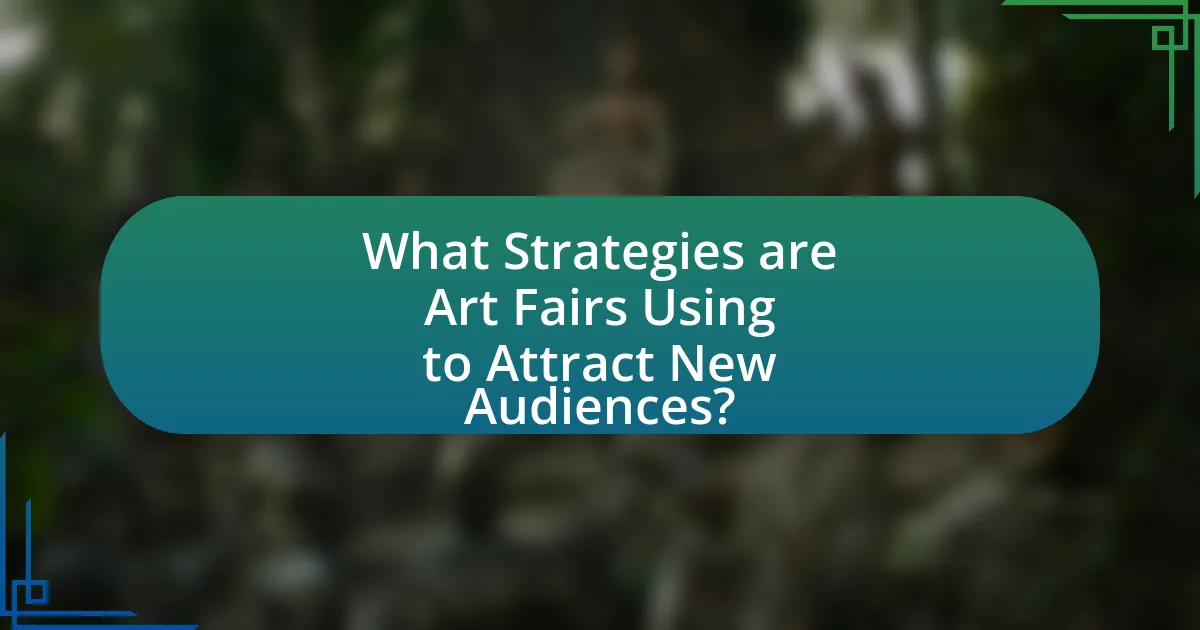
What Strategies are Art Fairs Using to Attract New Audiences?
Art fairs are employing various strategies to attract new audiences, including the integration of technology, diversification of programming, and enhanced accessibility. By utilizing virtual reality and augmented reality, art fairs create immersive experiences that engage tech-savvy visitors. Additionally, they are offering diverse programming such as panel discussions, workshops, and performances that appeal to a broader demographic. Enhanced accessibility measures, such as reduced ticket prices and family-friendly activities, further invite participation from different community segments. These strategies are supported by data indicating that art fairs that embrace technology and inclusivity see increased attendance and engagement from younger audiences.
How are art fairs diversifying their programming?
Art fairs are diversifying their programming by incorporating a wider range of artistic practices, including digital art, performance art, and community engagement initiatives. This shift reflects a growing recognition of the need to appeal to diverse audiences and adapt to contemporary cultural trends. For instance, many art fairs now feature dedicated sections for emerging artists and underrepresented communities, which enhances inclusivity and broadens the scope of artistic expression. Additionally, the integration of technology, such as virtual reality and online platforms, allows art fairs to reach global audiences, further diversifying their programming.
What types of events are being introduced to appeal to broader audiences?
Art fairs are introducing interactive installations, live performances, and community engagement activities to appeal to broader audiences. These types of events enhance visitor participation and create immersive experiences, making art more accessible and relatable. For instance, some art fairs now feature workshops and panel discussions that invite public involvement, fostering a sense of community and encouraging diverse participation. This shift is supported by trends indicating that audiences increasingly seek experiential and participatory art experiences, as evidenced by a rise in attendance at events that prioritize engagement over traditional viewing.
How are partnerships with local communities enhancing art fairs?
Partnerships with local communities are enhancing art fairs by fostering greater engagement and inclusivity, which attracts a more diverse audience. These collaborations often involve local artists, cultural organizations, and community leaders, resulting in programming that reflects the unique cultural identity of the area. For instance, art fairs that incorporate local themes or artists can increase attendance by appealing to community pride and interest. Additionally, studies have shown that art fairs that engage local communities see a rise in participation rates, as evidenced by the 2019 Art Basel Miami Beach, which reported a 30% increase in local attendance due to community partnerships. This approach not only enriches the art fair experience but also strengthens community ties and supports local economies.
What marketing strategies are effective for modern art fairs?
Effective marketing strategies for modern art fairs include leveraging social media platforms, creating immersive experiences, and utilizing data analytics for targeted outreach. Social media, particularly Instagram, has become a vital tool for galleries and artists to showcase their work and engage with potential buyers, as evidenced by the fact that 70% of art buyers use social media to discover new artists. Immersive experiences, such as virtual reality tours and interactive installations, attract visitors and enhance engagement, which has been shown to increase attendance by up to 30% at events that incorporate such elements. Additionally, data analytics allows organizers to identify trends and preferences among attendees, enabling more effective marketing campaigns that resonate with specific audiences, ultimately driving ticket sales and participation.
How are social media campaigns shaping the perception of art fairs?
Social media campaigns are significantly shaping the perception of art fairs by enhancing visibility and engagement among diverse audiences. These campaigns leverage platforms like Instagram and Facebook to showcase artworks, artists, and event highlights, creating a dynamic online presence that attracts both local and international visitors. For instance, a study by Art Basel and UBS in 2021 indicated that 70% of art fair attendees use social media to discover new artists and galleries, demonstrating the influence of digital platforms on audience perceptions. Additionally, social media allows for real-time interaction and feedback, fostering a sense of community and inclusivity that can redefine traditional views of art fairs as exclusive events.
What role do influencers play in promoting art fairs?
Influencers play a crucial role in promoting art fairs by leveraging their social media platforms to reach a wider audience and generate buzz around the events. They create engaging content that showcases the art, artists, and experiences at the fairs, which can significantly increase attendance and visibility. For instance, influencers often share live updates, behind-the-scenes looks, and personal insights, which can attract their followers’ interest and encourage them to participate. This strategy has been validated by studies showing that events promoted by influencers see higher engagement rates and ticket sales, demonstrating their effectiveness in the art fair ecosystem.
What are the best practices for art fairs adapting to new trends?
Art fairs can effectively adapt to new trends by incorporating digital platforms, enhancing visitor engagement, and prioritizing sustainability. The integration of online viewing rooms and virtual exhibitions allows art fairs to reach a broader audience, as evidenced by the success of Art Basel’s online viewing platform, which attracted over 100,000 visitors in its inaugural year. Additionally, interactive installations and immersive experiences can significantly enhance visitor engagement, as seen in the rise of experiential art events that encourage participation. Lastly, adopting eco-friendly practices, such as reducing waste and promoting sustainable art, aligns with the growing consumer demand for environmental responsibility, supported by a 2021 survey indicating that 70% of art buyers prefer to support sustainable initiatives.
How can art fairs effectively implement feedback from attendees?
Art fairs can effectively implement feedback from attendees by establishing structured channels for collecting and analyzing responses, such as surveys and focus groups. These methods allow organizers to gather specific insights on attendee experiences, preferences, and suggestions for improvement. For instance, a study by the International Council of Museums found that 70% of attendees prefer post-event surveys to provide feedback, indicating a clear preference for structured feedback mechanisms. By analyzing this data, art fairs can identify trends and areas for enhancement, such as improving layout, enhancing artist engagement, or adjusting programming. Implementing changes based on this feedback not only improves future events but also fosters a sense of community and responsiveness among attendees, ultimately leading to increased satisfaction and attendance.
What are the key considerations for balancing tradition and innovation?
Key considerations for balancing tradition and innovation in art fairs include understanding the historical significance of traditional practices while integrating contemporary trends to attract diverse audiences. Art fairs must respect established artistic values and cultural heritage, which can enhance credibility and foster community engagement. Simultaneously, embracing innovative technologies, such as virtual reality and digital platforms, can expand accessibility and reach new demographics. For instance, the rise of online art sales during the COVID-19 pandemic demonstrated how innovation can coexist with tradition, allowing art fairs to maintain relevance in a changing market.
